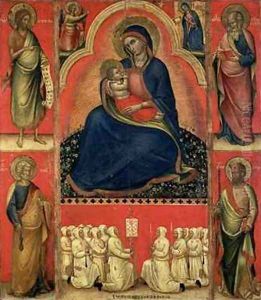Bologna Giovanni da Paintings
Giovanni da Bologna, often known as Giovanni da Bologna Fiorentino or simply as Giambologna, was an Italian Renaissance sculptor who was born around 1448 in Douai, Flanders, now in France. Despite his northern origins, he is frequently associated with the Italian city of Bologna due to his extensive work and influence there. However, it is important to note that there is some confusion regarding the artist known as Giovanni da Bologna since Giambologna, a renowned Mannerist sculptor, is also associated with the name, but he was born later, around 1529, and is distinct from Giovanni da Bologna Fiorentino.
Giovanni da Bologna's early life is not well-documented, which is typical for artists of this period. It is believed that he was trained in the art of sculpture in his native Flanders, which was renowned for its fine arts, especially painting and sculpture, during the late Gothic and early Renaissance periods. Flanders was a vibrant artistic center where the Northern Renaissance began to take shape, and it was characterized by a high degree of realism and attention to detail.
Giovanni da Bologna moved to Italy, which was the heart of the Renaissance movement, to further his career and to be part of the burgeoning art scene. He settled in Bologna, a city known for its university and as a center for learning and the arts. Here, he was influenced by the works of classical antiquity as well as the contemporary works of Italian masters. His style would have been a blend of Northern European Gothic traditions and the emerging Italian Renaissance aesthetics, which emphasized classical proportions, humanism, and naturalism.
While specific works attributed to Giovanni da Bologna Fiorentino are not well-known, and much of his life's details remain obscure, he would have been part of the generation of artists responsible for the transition from Gothic to Renaissance styles in Italy. His contributions would have included both religious and secular works, likely created for local churches, public spaces, and private patrons.
Giovanni da Bologna passed away in 1514. As with many artists of his time, his fame was likely eclipsed by later Renaissance figures whose works have been more extensively documented and preserved. Nonetheless, his role as a bridge between the Northern European Gothic traditions and the Italian Renaissance would have been significant in the cultural exchange that helped to shape the course of art history during this pivotal era.
